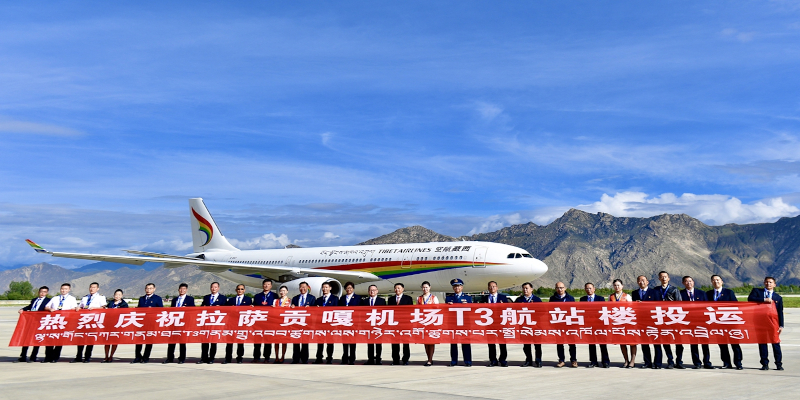Dharamshala, 10th August: On Saturday, the newly constructed Terminal 3 at Lhasa Gonggar Airport in Southwest China’s Tibet Autonomous Region, the region’s largest, opened for operations, marking a significant milestone in the region’s rapid infrastructure development that could significantly boost passenger and cargo transport and help the region become a global logistics hub for South Asia, experts said. According to the airport, with the new terminal, the airport will be able to handle 9 million people and 80,000 metric tonnes of cargo annually, accounting for more than 75 percent of all passenger traffic in Tibet.
The 88,000-square-meter terminal, which is nearly three times the size of the former terminal and includes a 21-stand parking apron, a supporting air traffic control center, and modern communication and airfreight facilities, was completed over three years ago. The expansion of Lhasa Gonggar Airport began in December 2017 with a 3.9 billion yuan ($603 million) investment.
According to Liu Zongyi, secretary-general of the Shanghai Institutes for International Studies’ Research Center for China-South Asia Cooperation, infrastructure construction in Tibet has intensified in recent years, with major civil aviation, railway, and highway projects. On Sunday, Liu told the Global Times, “This is intended to help transform the region into an international logistics hub for South Asia.”
According to the Xinhua News Agency, China has been increasing its infrastructure investment in the autonomous territory since late 2012, launching 130 aviation routes connecting 61 cities. The total number of passenger visits through these airports is expected to reach 5.18 million in 2020. Tibet also stated in April that it will construct three additional airports, including a second runway at the Lhasa Gonggar Airport.
“As many of them rely on the cold chain for effective and fast transit,” Liu added, “the enhanced infrastructure in Tibet is likely to boost tourism and promote local agriculture and animal husbandry products.”
According to official data, Lhasa Gonggar Airport handled 940 flights, 102,000 passenger trips, and 653 tonnes of cargo and mail during the May Day holiday this year, up 81.8 percent, 83.9 percent, and 14.3 percent, respectively, from 2020.
According to Lin Zhijie, a market watcher, the development of the airport is projected to considerably improve the travel experience and convenience of passengers flying to and from Tibet.
“While the T2 terminal’s original design capacity of 1 million passengers is already overburdened, the operation of T3 with a 9 million passenger handling capacity can greatly improve passengers’ travel experiences and make flying more convenient and comfortable,” Lin said, adding that the airport will help boost local economic development and improve livelihood in the region.
Lhasa Gonggar Airport, one of the world’s first high-altitude airports, opened in 1966 and is Tibet’s only international airport with international flights to Kathmandu, Nepal’s capital. Experts predict that more international aviation routes will be developed in the South Asia region in the future to improve trade and logistics transportation.
At the launch ceremony, Bai Zhen, director of China’s Civil Aviation Administration’s Tibet Bureau, said, “The completion of the Lhasa Gonggar Airport expansion project will effectively help Tibet to further integrate into [the Belt and Road Initiative] to promote regional economic and social development.”
Image Credit: globaltimes







Leave a Reply